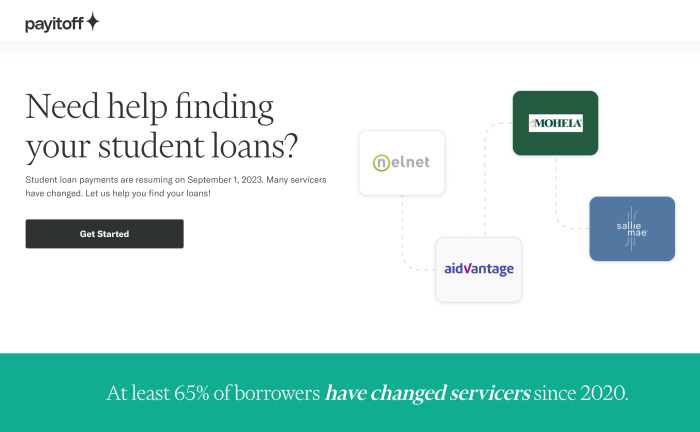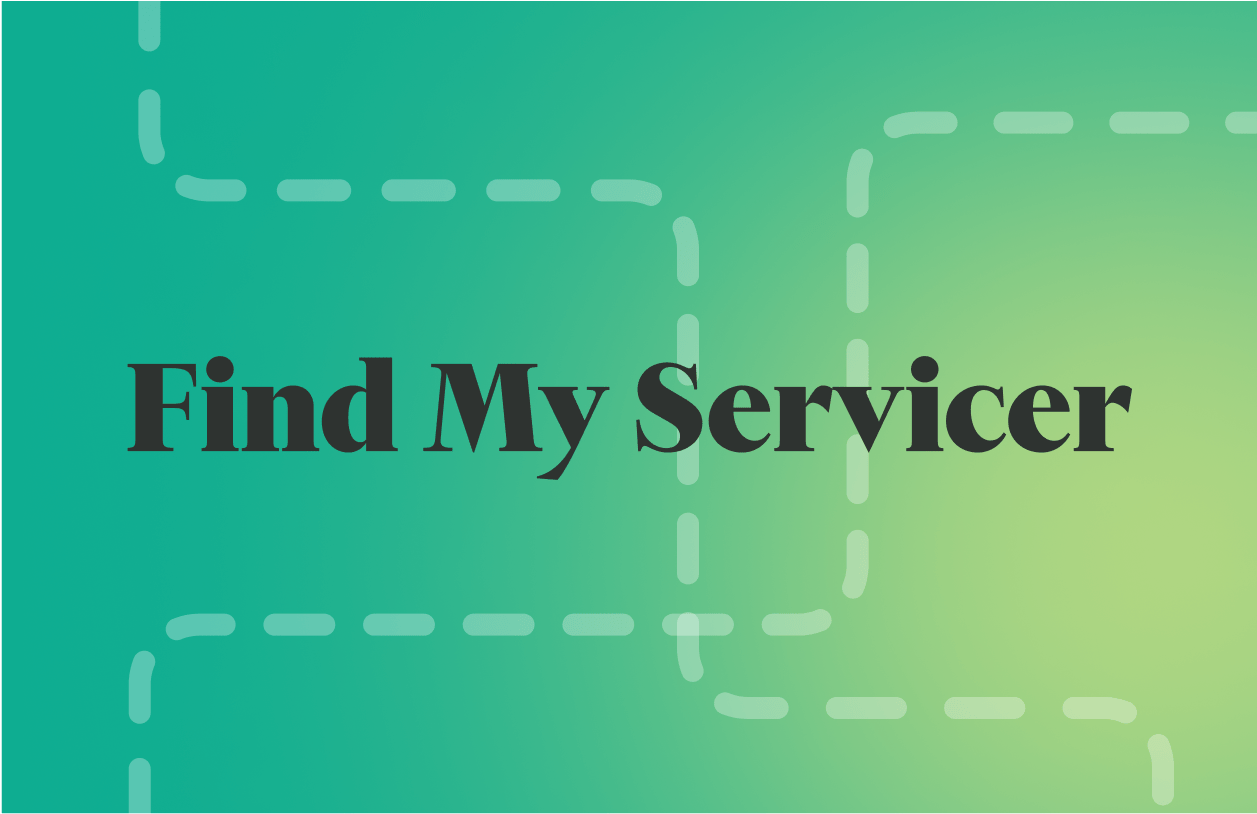
Navigating the world of student loans can feel overwhelming, especially when trying to locate your student loan servicer. Understanding who your servicer is and how to contact them is crucial for managing your payments, accessing your account information, and ensuring a smooth repayment process. This guide provides a clear and concise pathway to finding your servicer and effectively managing your student loan journey.
From understanding the roles and responsibilities of different servicers to mastering the art of contacting them, we’ll equip you with the knowledge and resources needed to confidently handle your student loan obligations. We’ll explore various methods for locating your servicer, including utilizing online portals and official government resources. We’ll also delve into common scenarios, such as servicer changes, and provide practical solutions for navigating these situations.
Understanding Student Loan Servicers
Navigating the complexities of student loan repayment can be challenging, and understanding the role of your student loan servicer is crucial for a smooth process. Your servicer acts as the intermediary between you and your loan lender, managing your account and facilitating repayment.
The Role of a Student Loan Servicer
Student loan servicers handle various aspects of your loan, including processing payments, answering your questions, providing account information, and managing your repayment plan. They are responsible for ensuring timely payments, applying payments correctly, and providing accurate account statements. Their actions directly impact your credit score and overall repayment experience. They don’t originate the loans, but they manage them after the lender issues them.
Types of Student Loan Servicers
Several types of entities can serve as student loan servicers. These often include private companies contracted by the government (for federal loans) or private lenders (for private loans). The government may also directly manage servicing for certain loan programs. The type of servicer you have will influence the specific services available to you.
Examples of Common Student Loan Servicers in the US
Several major companies handle a significant portion of the US student loan servicing market. Examples include Navient, Nelnet, Great Lakes, and FedLoan Servicing (now mostly defunct, with its loans transferred to other servicers). It’s important to note that the specific servicer for your loans might change over time.
Comparison of Services Offered by Different Servicers
While all servicers perform the core functions of receiving payments and providing account information, the quality and range of services can vary. Some servicers might offer more robust online portals, superior customer service, or a wider array of repayment plan options. Others may be known for their efficiency or their responsiveness to customer inquiries. It’s essential to research and compare the features offered by different servicers to find the best fit for your needs.
Comparison of Key Features of Three Major Servicers
This table provides a simplified comparison, and specific features and contact information may change. Always check the official servicer website for the most up-to-date information.
| Servicer | Contact Information | Online Portal Features | Payment Options |
|---|---|---|---|
| Nelnet | Website: nelnet.com; Phone: (800) 308-2308 | Account summary, payment history, repayment plan options, communication tools | Online payment, mail, phone |
| Navient | Website: navient.com; Phone: (800) 272-5542 | Account summary, payment history, repayment plan options, loan consolidation information | Online payment, mail, phone |
| Great Lakes | Website: greatlakes.org; Phone: (800) 230-4592 | Account summary, payment history, repayment plan options, forbearance and deferment applications | Online payment, mail, phone |
Locating Your Servicer
Finding the right student loan servicer is crucial for managing your repayments effectively. Knowing who your servicer is allows you to access your account information, make payments, and explore repayment options. Several reliable methods exist to quickly identify your loan servicer.
Several avenues exist for locating your student loan servicer. These include checking your federal student aid documents, utilizing the National Student Loan Data System (NSLDS), or contacting your lender directly. Each method provides a unique path to accessing this essential information.
Accessing Servicer Information Through the National Student Loan Data System (NSLDS)
The NSLDS is a central database maintained by the U.S. Department of Education. It provides a comprehensive overview of your federal student aid, including your loan servicer’s contact information. Accessing this information is generally straightforward and requires only your Federal Student Aid ID (FSA ID) and Social Security number.
Using the NSLDS website to locate your servicer involves a few simple steps. First, you will need to access the NSLDS website. Then, you will need to log in using your FSA ID. Once logged in, navigate to the section displaying your loan information. Your loan servicer will be listed alongside your loan details.
Locating Servicer Information on Federal Student Aid Documents
Your original loan documents, such as your promissory notes or award letters, often contain your servicer’s name and contact information. These documents are a primary source for this information and should be carefully reviewed. If you’ve misplaced these documents, you can usually request replacements from your original lender or the institution that disbursed the loans.
Step-by-Step Guide: Using the NSLDS Website
- Visit the NSLDS website: Navigate to the official NSLDS website. Be cautious of phishing sites imitating the official website.
- Log in with your FSA ID: Enter your FSA ID and password to access your student aid information. If you don’t have an FSA ID, you’ll need to create one before proceeding.
- Locate your loan information: Once logged in, find the section detailing your federal student loans. This section often displays a summary of your loans, including the servicer for each loan.
- Identify your servicer: Your servicer’s name and contact information should be clearly listed next to each loan. Note that you may have multiple servicers if you have loans from different programs or lenders.
Flowchart: Locating Your Servicer Using Online Resources
The following describes a flowchart illustrating the process. Imagine a box labeled “Start.” An arrow points to a box labeled “Access NSLDS website.” Another arrow leads from this box to a box labeled “Log in with FSA ID.” A subsequent arrow connects to a box labeled “Locate Loan Information.” From here, an arrow leads to a box labeled “Identify Servicer.” Finally, an arrow points from this box to a box labeled “End.” If at any point, you encounter problems, there’s a branch leading to a box labeled “Contact NSLDS Support” which then leads back to the appropriate box in the main flow.
Dealing with Servicer Changes

It’s not uncommon for your student loan servicer to change. This can be a somewhat unsettling experience, but understanding the reasons behind these changes and the proper steps to take can ease the transition. Knowing what to expect and how to proactively manage the process will help ensure a smooth handover of your loan accounts.
Servicer changes occur for various reasons. The Department of Education periodically reassigns loan servicing contracts to different companies through a competitive bidding process. This ensures ongoing oversight and aims to provide the best possible service to borrowers. Sometimes, servicers may merge or go out of business, necessitating a transfer of their loan portfolios to another company. These changes are typically beyond the borrower’s control.
Notification of Servicer Changes
When a servicer change occurs, you will receive official notification from both your current and new servicers. This notification, usually sent via mail and sometimes email, will clearly state the date of the transfer, the name and contact information of your new servicer, and instructions on how to access your account information with the new servicer. The notification should also explain any necessary steps you need to take, such as updating your contact information. It’s crucial to carefully read all communication regarding the change to avoid potential problems.
Steps to Take When Your Servicer Changes
Upon receiving notification of a servicer change, several actions should be taken to ensure a smooth transition. First, carefully review the notification to confirm the details of your new servicer. Next, locate your new servicer’s website and register for online access to your account. Familiarize yourself with the new servicer’s website and online tools. It’s also a good idea to review your loan terms and payment schedule to confirm that everything has been accurately transferred. Finally, make a note of the new servicer’s contact information, including phone number and mailing address, and keep this information readily accessible.
Updating Contact Information with Your New Servicer
Updating your contact information with your new servicer is vital to ensure you receive important communications regarding your loans. Most servicers have online portals where you can easily update your address, phone number, and email address. Look for a section labeled “Profile,” “Account Information,” or something similar. You may also be able to update this information by phone or mail, using the contact details provided in the servicer change notification. It’s essential to ensure your information is accurate to avoid missed payments or crucial updates.
Potential Problems and Solutions
It’s important to be aware of potential issues that may arise during a servicer transfer. While these are less common, they can be stressful if they occur.
- Problem: Lost or delayed payments. Solution: Keep records of all payments made, including confirmation numbers. Contact your new servicer immediately if a payment doesn’t appear on your account.
- Problem: Inaccurate loan information transferred to the new servicer. Solution: Contact both your old and new servicers to rectify any discrepancies in your loan details.
- Problem: Difficulty accessing your online account with the new servicer. Solution: Contact the new servicer’s customer service department for assistance.
- Problem: Missed communication regarding payment due dates or other important information. Solution: Proactively check your account online regularly, and update your contact information promptly.
Understanding Your Loan Information

Understanding your student loan statements is crucial for responsible loan management. Regularly reviewing these statements allows you to track your loan progress, identify potential errors, and ensure you’re making timely payments. Failing to do so can lead to missed payments, accruing interest, and ultimately, damage to your credit score.
Key Information on Student Loan Statements
Your student loan statement will contain several key pieces of information. This data is essential for understanding your loan’s current status and future repayment obligations. Accurate interpretation of this information empowers you to make informed decisions about your repayment strategy.
- Loan Balance: The total amount you still owe on your loan(s).
- Interest Rate: The percentage rate at which interest accrues on your unpaid balance.
- Monthly Payment: The amount you are required to pay each month.
- Payment Due Date: The date by which your monthly payment must be received.
- Payment History: A record of your past payments, showing the dates and amounts paid.
- Account Number: A unique identifier for your specific loan account.
- Principal and Interest Breakdown: A breakdown showing how much of each payment goes towards paying down the principal loan amount and how much goes towards interest.
Types of Information Displayed
Student loan statements present information in various formats to provide a comprehensive overview of your loan. Understanding these different presentation methods is key to efficiently analyzing your financial situation.
- Summary Information: A concise overview of your loan balance, payment due date, and minimum payment amount.
- Detailed Payment History: A chronological record of all payments made, including dates, amounts, and payment methods.
- Amortization Schedule (sometimes included): A table showing the projected repayment schedule, including principal and interest payments for each period until the loan is paid off.
- Interest Accrual Information: Details on how much interest has accrued since your last payment.
- Contact Information: Details of your loan servicer, including phone numbers and addresses.
Importance of Regular Review
Regularly reviewing your statements is vital for proactive loan management. Consistent monitoring helps prevent costly mistakes and ensures you stay on track with your repayment plan. Proactive review enables early detection of potential issues.
- Error Detection: Early identification of billing errors or discrepancies in payment processing.
- Payment Tracking: Confirmation that payments are being applied correctly and on time.
- Financial Planning: Accurate tracking of loan balances for effective budgeting and financial planning.
Common Mistakes to Avoid
Several common mistakes can hinder effective loan statement review. Avoiding these errors ensures accurate understanding and responsible loan management. Careful attention to detail is crucial for preventing financial setbacks.
- Ignoring Statements: Failing to open and review statements can lead to missed payments and penalties.
- Misinterpreting Information: Incorrectly understanding the terms and conditions of your loan can lead to financial difficulties.
- Not Tracking Payments: Failing to verify that payments are being properly applied to your loan balance.
Sample Student Loan Statement
Loan Account Number: 1234567890
Borrower Name: John Doe
Loan Balance: $25,000
Interest Rate: 5.0%
Monthly Payment: $250
Payment Due Date: 15th of each month
Last Payment Date: 2024-03-15
Last Payment Amount: $250
Interest Accrued Since Last Payment: $20
Next Payment Due Date: 2024-04-15
Summary

Successfully finding and engaging with your student loan servicer is a pivotal step in responsible loan management. By utilizing the methods and resources Artikeld in this guide, you can confidently navigate the complexities of student loan repayment. Remember to regularly review your loan statements, maintain updated contact information, and don’t hesitate to reach out to your servicer with any questions or concerns. Proactive engagement ensures a smoother repayment journey and helps you avoid potential pitfalls along the way.
FAQ Corner
What happens if I can’t find my student loan servicer?
Contact the Federal Student Aid (FSA) website or the National Student Loan Data System (NSLDS) for assistance. They can help you locate your servicer’s contact information.
How often should I contact my student loan servicer?
Regularly review your statements and contact your servicer if you have questions, notice discrepancies, or need to make changes to your payment plan. There’s no set frequency, but proactive communication is key.
What if my servicer changes?
You will receive notification from both your old and new servicers. Update your contact information with the new servicer promptly and review your loan details to ensure accuracy.
Can I change my student loan servicer?
Generally, you cannot choose your servicer. They are assigned by the Department of Education. However, if you have a problem with your current servicer, you can contact the FSA for assistance.
